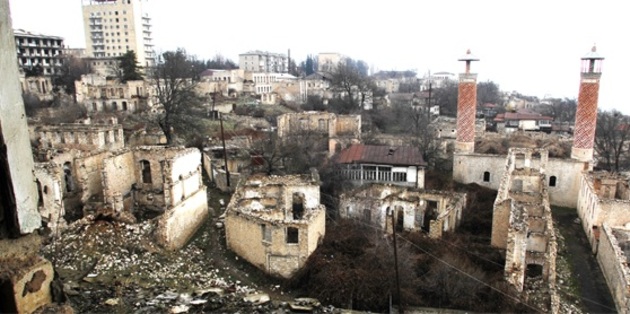The deal to end the ongoing Nagorno-Karabakh conflict, signed earlier this week by the presidents of Russia, Azerbaijan and the Prime Minister of Armenia, has already been called a historically important document. The end of the military escalation and peaceful return of the occupied territories to Azerbaijan became possible partly due to the liberation of Shusha.
The city, considered a symbol of Azerbaijanis from all over the world, the cradle of Azerbaijani culture, was under Armenian occupation for more than 28 years. In May 1992, after the Wedding in the Mountains operation carried out by the Armenian troops, Armenia established control over Shusha populated mainly by Azerbaijanis.
In 1992, the city was defended to the end by the legendary tanker, a hero of the Karabakh war, Jew by origin Albert Agarunov, who was killed by a sniper shot on May 8. After Agarunov's death, Azerbaijani tankers began to name their combat vehicles after him. These days, the authorities are going to unveil a monument to him in the place where the invaders once left the Armenian T-72 tank, which first burst into the city on May 8, 1992.
Shusha, located at a height and surrounded by roads, is of great strategic importance. It is only a stone’s throw away from the main Karabakh city - Khankendi, to which the entire infrastructure is tied. Shusha is considered the key to Karabakh: who controls this city controls all Karabakh.
Military experts say that the Azerbaijani army’s operation on the liberation of Shusha in November 2020 will live in history. Azerbaijani units bypassed the roads controlled by the occupation forces and advanced through the mountains, gorges, and small settlements. While the Armenian armed forces were preparing the defense, the mountain units of the Azerbaijani army, having passed through the mountains almost on foot, rounded the mountain range from three sides and reached the Lachin-Shusha highway, cutting it off and starting the operation on the outskirts of the city. They launched an assault, deciding to attack along the steep slope of the mountain where Shusha is located.
Experts compare this operation to the Battle of Vesuvius in 73 BC when escaped slaves fought against military force. Then Spartacus’ people made ropes and ladders from vines and trees growing on the slopes of the volcano and used them to rappel down the cliffs on the opposite side of the mountain. The gladiators moved around the base of Vesuvius and attacked the Roman soldiers. This tactic - to attack the enemy suddenly - was used by the Azerbaijani special mountain forces. However, their task was much more difficult - to climb up over the abyss, on the edge of which the Armenian forces stood.
The servicemen who soared over the abyss proved that the success of the Azerbaijani military was provided not only by the state-of-the-art technology. The outcome of the war was decided by the children of those who were expelled from their lands almost 30 years ago, and their brothers in arms. Speaking about the competent policy of the command, military analysts note that the Azerbaijani army was allowed to fight evenly without forcing the issue and sacrificing people to secure another height. The Azerbaijani troops took those junctions that could cause maximum damage to the enemy using unexpected tactics.
Not experiencing any political pressure the Azerbaijani army methodically defeated the enemy, and now, after the signing of the document on the settlement of the Nagorno-Karabakh conflict, the next step is the restoration of Shusha. Here we provide only one figure that is significant not from the economic point of view but as a cultural symbol that was mentioned at the beginning of the article. During the study of the damage to historical and cultural monuments in the occupied territories of Azerbaijan, carried out by the International Turkic Culture and Heritage Foundation, The ANAS Institute of Law and Human Rights and The National Commission of Azerbaijan for UNESCO, 215 historical and cultural monuments were damaged in Shusha. This is a very sad fact for the global community.
One way or another, the liberation of Shusha has enormous political, strategic and ideological significance. People will return to these lands, and, hopefully, they will live there in peace and harmony.






